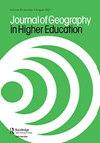了解城市动态:在基于问题的活动中使用地理位置的社交媒体作为调查工具,以促进学生的学习
IF 1
4区 教育学
Q2 EDUCATION & EDUCATIONAL RESEARCH
引用次数: 3
摘要
摘要在地理和城市研究高等教育项目中,将地理定位的社交媒体作为了解城市的调查工具进行教学使用的研究尚未得到充分利用。本研究通过探讨这些来源的可转移性,作为提高学生对城市现象知识的研究媒介。在阿利坎特大学建筑基础学位的城市研究三年级必修模块中,开展了一项基于问题的合作学习活动。西班牙语(25名学生)和英语(34名学生)两个小组参加了活动。Foursquare和Twitter数据集被用作信息来源,并在QGIS软件中提供了脚手架、数据分析和可视化工具。活动前和活动后的问卷调查以及学生提交的作业表明了活动对实现既定目标的有用程度。学生们反复采用的方法和他们对社交媒体信息的“操作方法”使他们能够将时空和社会现象与城市空间的使用和感知相结合。学生们培养了批判性思维和解释能力,这是理解当今数字化世界中大量可用数据的关键横向能力。本文章由计算机程序翻译,如有差异,请以英文原文为准。
Understanding city dynamics: using geolocated social media in a problem-based activity as an investigative tool to enhance student learning
ABSTRACT Research that tackles the pedagogical use of geolocated social media as an investigative tool for understanding cities in Geography and Urban Studies higher education programs has not been fully exploited. This study contributes by addressing the transferability of these sources as a research medium for enhancing student knowledge of urban phenomena. A collaborative problem-based learning activity was conducted in a third-year compulsory Urban Studies module of the Fundamentals in Architecture Degree at the University of Alicante. Two groups – Spanish (25 students) and English (34 students) language, participated in the activity. Foursquare and Twitter datasets were used as sources of information, and scaffolding in QGIS software, data analysis, and visualization tools were provided. Pre- and post- activity questionnaires as well as the work submitted by students gave an indication of the extent to which the activity was useful for achieving the set objective. Recurring approaches adopted by students and their “how-to” make sense of social media information enabled them to align spatiotemporal and social phenomena to the use and perception of city spaces. Students developed critical thinking and interpretative skills that are key transversal competencies for understanding the huge volume of data available in today’s digitalized world.
求助全文
通过发布文献求助,成功后即可免费获取论文全文。
去求助
来源期刊

Journal of Geography in Higher Education
Multiple-
CiteScore
5.80
自引率
9.50%
发文量
29
期刊介绍:
The Journal of Geography in Higher Education ( JGHE) was founded upon the conviction that the development of learning and teaching was vitally important to higher education. It is committed to promote, enhance and share geography learning and teaching in all institutions of higher education throughout the world, and provides a forum for geographers and others, regardless of their specialisms, to discuss common educational interests, to present the results of educational research, and to advocate new ideas.
 求助内容:
求助内容: 应助结果提醒方式:
应助结果提醒方式:


